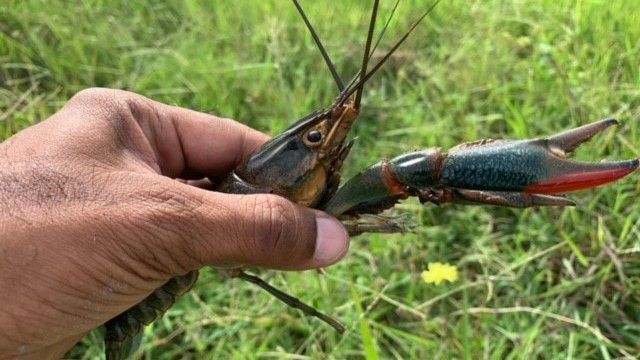BROWNSVILLE, Texas — The invasive Australian Redclaw Crayfish have been collected by researchers from the University of Texas Rio Grande Valley at the first known site in Texas. Between January and February of this year, three specimen were collected from an apartment complex pond that connects to a nearby resaca in the Brownsville area.
A female specimen carrying her young was seen in 2013, indicating that this species has been at this location for a while. Besides California, this is the second detection of the crayfish in the wild in the United States.
Texas Parks and Wildlife aquatics biologist Dr. Archis Gubh also surveyed the area in July and found three more crayfish between the apartment pond and the nearby resaca.
“We don’t know when these invasive crayfish were first introduced or how far they have spread, but we do know they can have a negative effect on local species and biodiversity,” said Grubh. “Spreading the word about this invasive species and reporting sightings to TPWD can help us better understand where it is distributed and potentially take steps to help prevent its spread.”
Concerns of the species reproducing have been raised as both male and female Australian Redclaw Crayfish have been collected. Females brood up to five times a year and can lay 1,000 eggs per clutch. The species grows fast and weigh up to two pounds in less than a year. These crayfish can significantly alter vegetation and habitat, as well as impact fish communities through direct predation. They can also carry the Crayfish Plague and other parasites or diseases that can impact native crayfish.
Australian Redclaw Crayfish are prohibited species in Texas and cannot be legally purchased, sold or possessed in aquariums. Releasing them into public bodies of water is also illegal.
"Release of aquarium life is unfortunately a key means by which invasive species such as these crayfish are introduced,” said Monica McGarrity, TPWD senior scientist for aquatic invasive species. “Well-meaning, uninformed aquarium owners sometimes release their pets thinking they’re doing the best thing for them, but if they do survive, they can become invasive and harm the native aquatic species and ecosystem. Aquarium owners should research alternatives to aquarium dumping and help prevent introductions of the next invasive species.”
These specific crayfish are identifiable by their large left claws with a red patch on the outer edge. They also have four distinct ridges on the top of their head. They like to habitate in slow-moving streams or stagnant bodies of water. The Australian Redclaw Crayfish are mobile over moist terrestrial vegetation and can move across water bodies. The chances of being introduced to new areas increases with more rainfall, as that can wash them across bodies of water.



